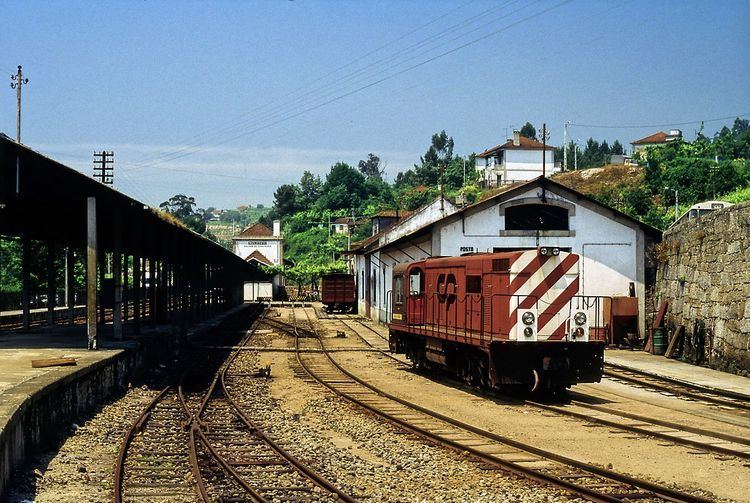Portugal formerly had several hundred kilometres of narrow-gauge railways, but by 2010 only two lines were still in operation – the Vouga line and the Metro de Mirandela. The lines were operated by Comboios de Portugal and maintained by REFER (or the predecessor CP).
The majority of railway lines in Portugal were built to 1,668 mm (5 ft 5 21⁄32 in) Iberian gauge. To reduce construction costs, some lines (notably in rural and mountainous parts of the country) were built to narrow gauge. Portugal's narrow gauge railways were largely built to metre gauge. The lines were mostly constructed from the 1880s onwards, with the final line not completed until as late as 1949. The first major wave of closures took place in the 1980s, notably the Sabor line and the Dão line. The northern extremities of the Corgo, Tâmega and Tua lines (all running north from main Douro line through the Douro Valley) were closed in 1990/1, with the rest of these lines closing in 2008/9.
Metro de Mirandela is a small part of the Tua line around the Mirandela Municipality, where diesel railcars maintain a passenger service.Vouga line: is the last remaining narrow-gauge line operated by Comboios de Portugal. As of October 2012 the line is still operating, but the entire Vouga line is facing the prospect of closure. It runs from junctions on the Oporto to Lisbon main line at Espinho to Sernada do Vouga and back to the same main line at Aveiro, This line has a museum at Macinhata do Vouga whilst the main workshops are at Sernada do Vouga. In 1990 the line was closed between Sernada do Vouga and Viseu (the Viseu branch line), but as of October 2012 is still working between Aveiro–Sernada do Vouga–Albergaria-a-Velha–Oliveira de Azeméis–Espinho.Dão line: this line ran between Santa Comba Dão and Viseu. It was closed to freight in 1972 and passengers in 1988.Penafiel to Lixa and Entre-os-Rios line: this line, which met the Douro line at Penafiel, closed in the late 1920s after less than 20 years of service.Sabor line: this line ran from Pocinho to Duas Igrejas, passing through very rural areas in the north-east of the country. The line closed in 1988.Tâmega line: this line ran between Livração and Amarante in the District of Oporto, near the River Tâmega. In 1949 the line was extended as far north as Arco de Baúlhe, but this section closed in 1990. The remaining part of the line closed in 2009.Corgo line: this line ran from Regua, on the Douro River to Vila Real. The line previously ran further north to Chaves (until 1990). The line closed in 2008. There is a small Railway Museum at Chaves.Tua line: this highly scenic line ran north from Tua to Mirandela and ran further north (until 1990) to Bragança. The line was closed temporarily on 10 April 2008 after a landslide which cause the derailment of a light inspection vehicle near Santa Luzia station. In 2009 the closure became permanent, apart from the Metro de Mirandela section. Part of the course of the line may be flooded by a hydro-electric reservoir project. The Metro de Mirandela is a small part of the Tua line around the Mirandela Municipality, where diesel railcars maintain a passenger service.Guimarães line: this line (Oporto-Guimarães-Fafe) was built as a metre-gauge line. It closed between Guimarães and Fafe in 1986; the trackbed was converted into a cycle way. The rest of the Guimarães line (west of Guimarães to Oporto) was converted to broad 1,668 mm (5 ft 5 21⁄32 in) Iberian gauge in 2004.Converted to standard gauge (metro)
Porto to Póvoa and Famalicão line: this formed the basis of the narrow-gauge section of Porto's suburban railway system, starting from Trindade station in Porto along with the Guimarães line. The narrow-gauge lines are no longer in operation, but part of the trackbed of this system has been rebuilt for use by the Porto Metro.The narrow-gauge lines were steam-operated for much of their existence. Diesel railcars were introduced as an economy measure in the 1940s, notably the Série 9100 built in Sweden for the Tâmega line in 1949 and the Dutch-built Série 9300 railcars used on several other lines from the early 1950s onwards. The Série 9700 diesel multiple units were purchased secondhand from the Yugoslav Railways in 1980, but frequently proved unreliable.
Metre-gauge diesel locomotives were built to replace steam haulage, especially on freight or mixed trains, notably the Série 9020 built in 1976. Steam remained in use on some lines until the 1980s.
The tram system in Lisbon, operated by Carris, is also narrow gauge – with a 900 mm (2 ft 11 7⁄16 in) track gauge.

